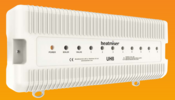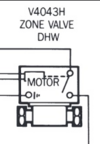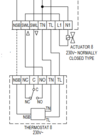Hello all,
Hope you are having a good day.
I'm looking to replace the analogue Siemens RAA21 thermostats currently installed in my flat with Moes Smart Thermostats. I am hoping someone here can guide me which would be the correct Moes variant I should purchase and also how they should be wired.
Some further detail...
These Siemens thermostats control the underfloor heating system. A number of these are fitted in various rooms/zones. When the setting increases beyond a certain point, it makes a click sound and I can see that the underfloor heating system is then activated. The underfloor heating system uses the Emmeti EWC-2 8 WAY WIRING CENTRE as its connection box.
Below are pictures of how the existing thermostats are wired:


and this is its official wiring guide:

I would like to replace all of them with Moes Smart Thermostats. These come in three variants with different wiring requirements, and I am unclear which variant would be the appropriate one for my scenario and also how it should be wired. Please see below the 3 variants and their wiring guides:

I assumed I would use the 'GA - Water Floor Heating' variant but that didn't work. My hunch is that I instead need the 'GC - Gas Boiler Heating' instead as that involves a dry contact, but was hoping to get some guidance from people far more experienced than myself in this area
Any assistance with this would be massively appreciated!
Thanks
Ratul
Hope you are having a good day.
I'm looking to replace the analogue Siemens RAA21 thermostats currently installed in my flat with Moes Smart Thermostats. I am hoping someone here can guide me which would be the correct Moes variant I should purchase and also how they should be wired.
Some further detail...
These Siemens thermostats control the underfloor heating system. A number of these are fitted in various rooms/zones. When the setting increases beyond a certain point, it makes a click sound and I can see that the underfloor heating system is then activated. The underfloor heating system uses the Emmeti EWC-2 8 WAY WIRING CENTRE as its connection box.
Below are pictures of how the existing thermostats are wired:
and this is its official wiring guide:
I would like to replace all of them with Moes Smart Thermostats. These come in three variants with different wiring requirements, and I am unclear which variant would be the appropriate one for my scenario and also how it should be wired. Please see below the 3 variants and their wiring guides:
I assumed I would use the 'GA - Water Floor Heating' variant but that didn't work. My hunch is that I instead need the 'GC - Gas Boiler Heating' instead as that involves a dry contact, but was hoping to get some guidance from people far more experienced than myself in this area
Any assistance with this would be massively appreciated!
Thanks
Ratul






